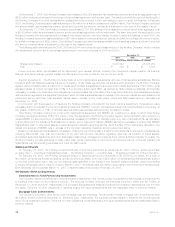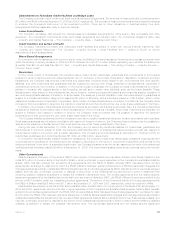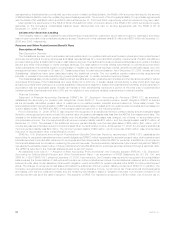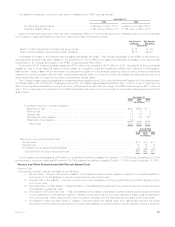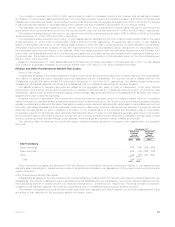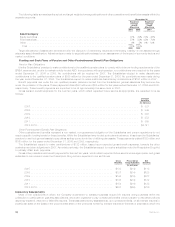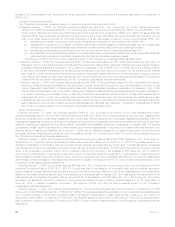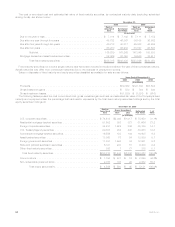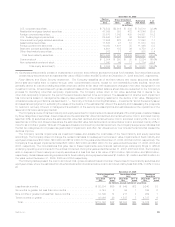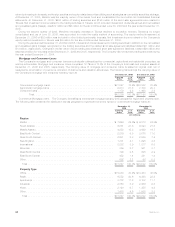MetLife 2006 Annual Report Download - page 61
Download and view the complete annual report
Please find page 61 of the 2006 MetLife annual report below. You can navigate through the pages in the report by either clicking on the pages listed below, or by using the keyword search tool below to find specific information within the annual report.excess of the compensation cost recognized for those options be classified and reported as a financing cash inflow upon adoption of
SFAS 123(r).
Derivative Financial Instruments
The Company has adopted guidance relating to derivative financial instruments as follows:
• Effective January 1, 2006, the Company adopted prospectively SFAS No. 155, Accounting for Certain Hybrid Instruments
(“SFAS 155”). SFAS 155 amends SFAS No. 133, Accounting for Derivative Instruments and Hedging (“SFAS 133”) and SFAS No. 140,
Accounting for Transfers and Servicing of Financial Assets and Extinguishments of Liabilities (“SFAS 140”). SFAS 155 allows financial
instruments that have embedded derivatives to be accounted for as a whole, eliminating the need to bifurcate the derivative from its
host, if the holder elects to account for the whole instrument on a fair value basis. In addition, among other changes, SFAS 155:
(i) clarifies which interest-only strips and principal-only strips are not subject to the requirements of SFAS 133;
(ii) establishes a requirement to evaluate interests in securitized financial assets to identify interests that are freestanding
derivatives or that are hybrid financial instruments that contain an embedded derivative requiring bifurcation;
(iii) clarifies that concentrations of credit risk in the form of subordination are not embedded derivatives; and
(iv) amends SFAS 140 to eliminate the prohibition on a qualifying special-purpose entity (“QSPE”) from holding a derivative financial
instrument that pertains to a beneficial interest other than another derivative financial interest.
The adoption of SFAS 155 did not have a material impact on the Company’s consolidated financial statements.
• Effective October 1, 2006, the Company adopted SFAS 133 Implementation Issue No. B40, Embedded Derivatives: Application of
Paragraph 13(b) to Securitized Interests in Prepayable Financial Assets (“Issue B40”). Issue B40 clarifies that a securitized interest in
prepayable financial assets is not subject to the conditions in paragraph 13(b) of SFAS 133, if it meets both of the following criteria:
(i) the right to accelerate the settlement if the securitized interest cannot be controlled by the investor; and (ii) the securitized interest
itself does not contain an embedded derivative (including an interest rate-related derivative) for which bifurcation would be required
other than an embedded derivative that results solely from the embedded call options in the underlying financial assets. The adoption
of Issue B40 did not have a material impact on the Company’s consolidated financial statements.
• Effective January 1, 2006, the Company adopted prospectively SFAS 133 Implementation Issue No. B38, Embedded Derivatives:
Evaluation of Net Settlement with Respect to the Settlement of a Debt Instrument through Exercise of an Embedded Put Option or Call
Option (“Issue B38”) and SFAS 133 Implementation Issue No. B39, Embedded Derivatives: Application of Paragraph 13(b) to Call
Options That Are Exercisable Only by the Debtor (“Issue B39”). Issue B38 clarifies that the potential settlement of a debtor’s obligation
to a creditor occurring upon exercise of a put or call option meets the net settlement criteria of SFAS 133. Issue B39 clarifies that an
embedded call option, in which the underlying is an interest rate or interest rate index, that can accelerate the settlement of a debt
host financial instrument should not be bifurcated and fair valued if the right to accelerate the settlement can be exercised only by the
debtor (issuer/borrower) and the investor will recover substantially all of its initial net investment. The adoption of Issues B38 and B39
did not have a material impact on the Company’s consolidated financial statements.
Other Pronouncements
Effective November 15, 2006, the Company adopted SAB No. 108, Considering the Effects of Prior Year Misstatements when
Quantifying Misstatements in Current Year Financial Statements (“SAB 108”). SAB 108 provides guidance on how prior year misstatements
should be considered when quantifying misstatements in current year financial statements for purposes of assessing materiality. SAB 108
requires that registrants quantify errors using both a balance sheet and income statement approach and evaluate whether either approach
results in quantifying a misstatement that, when relevant quantitative and qualitative factors are considered, is material. SAB 108 permits
companies to initially apply its provisions by either restating prior financial statements or recording a cumulative effect adjustment to the
carrying values of assets and liabilities as of January 1, 2006 with an offsetting adjustment to retained earnings for errors that were
previously deemed immaterial but are material under the guidance in SAB 108. The adoption of SAB 108 did not have a material impact on
the Company’s consolidated financial statements.
Effective January 1, 2006, the Company adopted prospectively Emerging Issues Task Force (“EITF”) Issue No. 05-7, Accounting for
Modifications to Conversion Options Embedded in Debt Instruments and Related Issues (“EITF 05-7”). EITF 05-7 provides guidance on
whether a modification of conversion options embedded in debt results in an extinguishment of that debt. In certain situations, companies
maychangethetermsofanembeddedconversionoptionaspartofadebt modification. The EITF concluded that the change in the fair
valueofanembeddedconversionoptionuponmodificationshouldbeincludedintheanalysisofEITFIssueNo.96-19,Debtor’s
Accounting for a Modification or Exchange of Debt Instruments, to determine whether a modification or extinguishment has occurred and
that a change in the fair value of a conversion option should be recognized upon the modification as a discount (or premium) associated
with the debt, and an increase (or decrease) in additional paid-in capital. The adoption of EITF 05-7 did not have a material impact on the
Company’s consolidated financial statements.
Effective January 1, 2006, the Company adopted EITF Issue No. 05-8, Income Tax Consequences of Issuing Convertible Debt with a
Beneficial Conversion Feature (“EITF 05-8”). EITF 05-8 concludes that: (i) the issuance of convertible debt with a beneficial conversion
feature results in a basis difference that should be accounted for as a temporary difference; and (ii) the establishment of the deferred tax
liability for the basis difference should result in an adjustment to additional paid-in capital. EITF 05-8 was applied retrospectively for all
instruments with a beneficial conversion feature accounted for in accordance with EITF Issue No. 98-5, Accounting for Convertible
Securities with Beneficial Conversion Features or Contingently Adjustable Conversion Ratios, and EITF Issue No. 00-27, Application of
Issue No. 98-5 to Certain Convertible Instruments. The adoption of EITF 05-8 did not have a material impact on the Company’s
consolidated financial statements.
Effective January 1, 2006, the Company adopted SFAS No. 154, Accounting Changes and Error Corrections, a replacement of APB
Opinion No. 20 and FASB Statement No. 3 (“SFAS 154”). SFAS 154 requires retrospective application to prior periods’ financial statements
for a voluntary change in accounting principle unless it is deemed impracticable. It also requires that a change in the method of
depreciation, amortization, or depletion for long-lived, non-financial assets be accounted for as a change in accounting estimate rather
than a change in accounting principle. The adoption of SFAS 154 did not have a material impact on the Company’s consolidated financial
statements.
58 MetLife, Inc.


